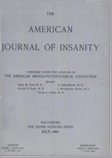Abstract
This presentation, bringing purely clinical problems of psychoanalytic therapy to the foreground, has been made in the hope that it will encourage a more open consideration of the clinical results of the method. Through group comparisons of variegated clinical experiences we may establish somewhat more accurately the method of procedure best suited to specific types of psychopathological reactions. I will not say for specific diagnoses because I think that clear-cut cases of any form of psychoneurosis are rarely seen.
In summarizing, I would like to mention the following points: (1) that reports of treatment from psychoanalytic sources presented in statistical form indicate that approximately 60 per cent of all cases were considered recovered or improved; (2) that this percentage closely approximates that reported from institutes where intensive psychoanalysis had not been used; (3) that at times strikingly satisfactory results can be obtained by brief treatment conducted on strictly psychoanalytic lines—so much so that (4) the question arises whether, when there is too great or too deep preoccupation with the unconscious, this does not retard synthesis between conscience and primitive drives; (5) that while lengthy and deep analyses are today most in favor, there has been no investigation to correlate the permanency and quality of result with the length and/or depth of treatment; (6) analyses which are discontinued are frequent and tend to lessen confidence in psychoanalytic method. The reasons for such interruptions have not been specifically or widely studied; (7) the tapering off of treatment appears valuable especially in border-line and psychotic cases that are being treated in increasing numbers by psychoanalysis (8) of the reaction types where psychoanalysis seems to encounter most favorable results may be mentioned anxiety neurosis and conversion hysteria; least favorable is the intellectual narcissist and the individual who recedes into deep depression or expands into a manic hyperactivity when faced with analytic revelations; (9) from my experience cases who avoid hospitalization because of their analyses far outnumber those who require hospitalization after analysis.
Many of this psychoanalytically trained audience may interpret most of my presentation as being due to my own feeling of insecurity, or less charitably, as being dependent on real defects in skill. Concerning the doubts, it cannot be denied that some of the high hopes regarding the wide scope and certainty of results with psychoanalytic therapy entertained by others as well as myself have not been sustained. That enormous and momentous although no essentially basic differences of opinion exist among analysts in many matters is indicated by replies to the questionnaire already mentioned. Perhaps if greater caution and sobriety has developed concerning the range of psychoanalysis, it is rather that the crackling flames of fresh fire have settled down to a warm and steady glow.
Nevertheless a certain amount of discomfiture or incertitude about theory, methodology and results must exist among many analysts. Nothing else could account for the numerous and violent controversies in psychoanalytic groups here and abroad, the frequent attempts to introduce new systems, the polemics emphasizing some phase of the general theory as specific or all important. These differences are not sufficient to warrant a regression of those who wish to reject portions of psychoanalytic theory to the infantile level of sullen petulance, nor to indulge in a temptation to form new groups, nor to succumb to the soothing solace of self-analysis.
Possibly a general over-enthusiasm thirty years ago, based upon such cases as the hallucinating patient cited above, may account for some of the present discomfiture. Such successes with the clear cause and effect relationship were dramatically impressive when they first appeared in psychoanalytic literature and when psychiatrists first became acquainted with the stimulating vista opened by psychoanalysis. Concerning present difficulties one of Freud's pithy epigrams seems particularly apt at this point—"if we cannot see clearly, let us at least see what is unclear clearly."
Perhaps a greater frankness than is sometimes customary occurs in this paper, but may it be without offense to any of my listeners and to the eventual benefit of the clinical application of psychoanalytic therapy and its far-reaching influence upon the management and restoration to health of psychiatric patients.

